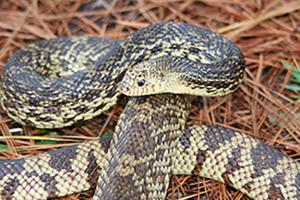Louisiana Pine Snake
Considered to be one of the rarest snakes in North America, The Louisiana pine snake (Pituophis ruthveni) calls the lush Longleaf pine savannas of west Louisiana and east Texas home.

Considered to be one of the rarest snakes in North America, The Louisiana pine snake (Pituophis ruthveni) calls the lush Longleaf pine savannas of west Louisiana and east Texas home. Known for producing the largest eggs and hatchlings of any U.S. snake, the black, brown and russet colored snake grows as large as 5 feet long.
Rarely seen in the wild, the LA pine snake spends much of its life underground in pocket gopher burrow systems. Pocket gophers appear to be their primary food source although they will consume other small rodents, amphibians and eggs from ground nesting birds. Some individuals believe that the LA pine snake has experienced years of population decline. One of the identified threats for the LA pine snake is the lack of early successional habitats within open forests of the western Gulf Coastal Plain, including a diverse and species rich herbaceous understory layer in pine stands.
Conservation practices that maintain or establish open, herbaceous-dominated vegetative understory conditions would aid against the identified threat. Appropriate longleaf or shortleaf pines should be encouraged as the tree species of choice for restoration.
The LA pine snake is listed as a candidate species for listing under the Endangered Species Act (ESA). To help reverse the decline and avoid federal listing of the LA pine snake, NRCS is working with private landowners in Louisiana and Texas to increase available habitat to support the snake’s recovery through land protection as well as restoration and enhancement of habitat.
Landowners in these two states will make improvements on 5,000 acres of working lands. With the help of NRCS, landowners will implement conservation practices that will restore longleaf pine trees and work to maintain or establish open, herbaceous dominated understory conditions in existing pine stands. Primary conservation practices will include tree and shrub establishment, prescribed burning, thinning and herbicide treatments to reduce woody shrubs.
The goal is to create favorable conditions for a diverse herbaceous understory in the pine stands. In creating this desirable habitat, many other wildlife species will benefit as well including the red cockaded woodpecker, Eastern wild turkey, Northern bobwhite quail and Henslow’s sparrow.
NRCS offers technical and financial assistance to help agricultural producers voluntarily improve habitat for this species. This assistance helps producers plan and implement a variety of conservation activities or practices that benefit an entire ecosystem.
Technical assistance is free to producers. The agency’s staff of experts and conservation partners work side-by-side with producers to develop a conservation plan. Each plan focuses on the current site conditions and habitat. Then, staff works with the landowner to develop a strategy to improve habitat conditions while meeting the goals of the landowners. These plans provide a roadmap for how to use a system of conservation practices to meet natural resource and production goals.
Financial assistance helps producers pay for the adoption of conservation systems that improve the health of the habitat and ecosystems. Common conservation practices include brush management, forest stand improvement, site preparation, tree establishment, firebreaks and upland wildlife habitat management.
This two state project is part of the Working Lands for Wildlife (WLFW) partnership, a collaborative approach to conserve habitat on working lands. WLFW provides technical and financial assistance through the Environmental Quality Incentives Program, Agricultural Conservation Easement Program and Healthy Forests Reserve Program, all conservation programs of the Farm Bill, the largest funding source for conservation on private lands.


